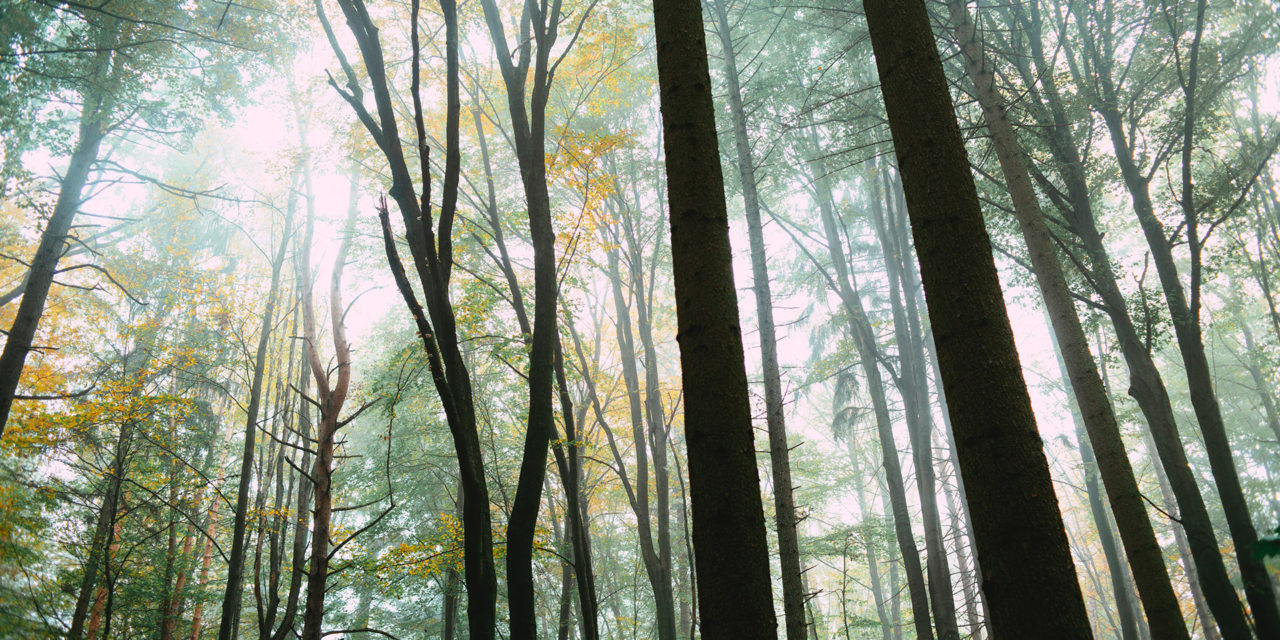I step off the northeast corner of our little farm and into a forest. It’s just a copse really; semi-trucks can be heard barrelling down the roads that border two sides of this small Eden in the midst of Surrey, British Columbia. But despite its diminutive size this woodland packs a biodiverse punch. On my arboreal path I have encountered white tail deer, an American beaver, red-legged frogs, river otters, rough skinned newts and birds of copious variety from owls to warblers to heron flying in cruciform overhead. And then there are the trees—magnificent Douglas firs and towering western red cedars whose branches drape like shawls on the shoulders of giant women.
I spend time in this forest to fulfill a vow—a vow to map my place with my walking. To wake every day to the gratuitous wonders served up by the hand of a generous Creator. To breath in creation, and in that breathing find myself restored, recalibrated, more like the Christian I want to be—calm, centered, kind.
It sounds very Walden-Pond wonderful, doesn’t it? So much so that even I, an everyday forest walker, am tempted to roll my eyes and get on with my daily work of making the world a better place. Get on with the task of becoming more like Jesus. Yet the truth is: Time spent in nature can make us better people—and ultimately better influencers for good in the world.
While many who live in Cascadia recognize this as truth, there are no doubt skeptics among my readers as well. To them I contend that both science and Jesus back me up on the restorative power of nature. Studies have shown that walking in woods lowers the stress hormone cortisol in the brain, increases cerebral blood flow, strengthens immunity, and improves overall mental health. Health benefits, I might add, that the same amount of walking on a treadmill do not confer.
This is why in the mid to late 1800’s doctors and hospital administrators built tuberculosis sanatoriums near woodlands. Patients who spent time under trees got well faster and in greater percentages than patients in the city sanatoriums. Recent studies have shown that even if people can’t walk or sit under trees, just being near or seeing plants has health benefits. In a fascinating ten-year study at a Pennsylvania hospital it was shown that patients recovering from gallbladder surgery in rooms with a forest view recovered remarkably faster and required less pain medication than patients recovering from the same surgery in rooms with views of brick buildings. One Norwegian study showed that even office workers with a view of a plant (not even a whole forest, but just one solitary house plant) recorded fewer sick days than officemates who had no view of a plant.
Such pro-fauna findings in research go on and on and have been applied to everything from ADHD (yes, forest walking reduces symptoms in children) to the reduction of depression, high blood pressure and road rage. Yet why do plants make us healthier and happier? The answer is long, but it has to do with things like the aromatic chemicals evergreen trees emit, as well as the negative ions—those charged particles found in abundance in forests and near moving water—both of which promote the release of happy hormones and antioxidants in humans. [1]
Besides the physiological benefits, a recent theory on the plant-brain relationship centers around a psychological benefit dubbed the “provocation of fascination” effect. In other words, forests incite fascination (aka wonder), and wonder is psychologically good for us. It is also good for those around us. A study in the Journal of Personality and Social Psychology shows empirically that people who participate in wonder-inducing activities are more altruistic. In other words, people who regularly look at trees or the night sky are more likely to make their world a better place.
Really though, none of this should come as a surprise. Two thousand years ago Jesus called his followers to become as little children. Have you watched a little child in nature lately? It’s a veritable wonder-fest—an emotionally recalibrating, kindness-inducing wonderfest.
If we pay attention to Jesus’ life as recorded in the Gospels, it is clear that he was the ultimate outdoorsman. Any storyteller will tell you that the setting of a narrative is important. If the setting is well-constructed then the reader can’t even imagine the story outside the contextual backdrop of that place. Take Huck Finn riding a raft down on slow moving Mississippi—or Bilbo strolling through the bucolic fields of the Shire. In all these examples, place gives meaning to the story. Importantly, much of Jesus’ life is set in the outdoors. Consider: Jesus was born outside (in a cave surrounded by animals) and died outside. He begins his ministry outside, first in a river at his baptism, where an animal (a dove) marks the anointing of his ministry; and then in the wilderness, where Mark’s gospel tells us that “wild animals were his companions and angels attended to him.”
His work and teachings are physical and earthy. Besides being inside for meals and a few gatherings, the Gospel narratives almost exclusively place Jesus outside, where he does all sorts of earthy things: from touching bodies, to walking on water, to multiplying fish and loaves, to using spit and dirt to heal. He preaches on mountainsides and on the water from a boat. When he needs the peace and companionship of God, he slips away to the shores of a lake or to a hillside. And the stories Jesus tells are filled with sheep, goats, fish, fields, flowers, birds, bread, yeast, pearls, seeds, sand, rocks, floods, vines, vineyards, thorn bushes, thistles, wine, water, wheat, wolves, and foxes.
So what does all this tell us about Jesus? How can seeing this obvious thing about Jesus—that his preferred places of prayer and teaching, as well as his preferred choice of setting and metaphor—was the stuff of the outdoors?
The answer to this question seems obvious: Jesus discovered wisdom and the presence of God in Creation. Perhaps the reason he was able to produce all those parables seemingly on the spot was because he had already wandered the hills and lakesides as a young man. He had already looked around at the birds, fields, and flowers, and learned to hear the voice of his Father. Way before Jesus ever said, “Consider the lilies of the fields,” he himself had actually considered the lilies of the fields. Actual lilies growing in actual fields that were familiar to him.
Jesus found refreshment and reorientation in creation. It seems obvious from his “consider the lilies and the birds of the air” passage, that he found not just emotional refreshment, but spiritual refreshment as well. Creation itself was the arena of God’s action and care. In his considering, Jesus saw that God cared for these seemingly insignificant things, like wildflowers that were a dime a dozen, or bits of vegetation that could be trampled upon without thought. God cared for these little vulnerable things. God clothed them in beauty beyond even what a king could afford. And if God cared for something as fleeting as a flower, how much more would he care for him?
John Crossan rightly reflects on what is going on with Jesus in this passage:
Where God’s care for nature’s birds and flowers should obviate human worries about food and clothing. . . . The serenity and security passed by Jesus to his followers derives not from knowing hidden mysteries of past or present but from watching nature’s rhythms of here and now. [2]
As an observant Jew, Jesus was following a tradition that saw God in creation. Jesus’s biblical ancestors encountered God in an oak tree, a burning bush, a cloud, a mountain, a stone pillow, a raven, and a gentle wind (to name a few). They didn’t confuse these things with being God, but saw them as places where the divine could show up.
Is it any wonder given Jesus’ affinity for and observation of creation then that when Mary found Jesus in the garden after the resurrection she mistook him for the gardener? Regarding this encounter we’re given no explanation from Paul or any other New Testament writer, so we’re left to surmise. Could it be that she mistook him for the gardener because he was gardening? Who knows! It’s certainly the most logical and straight-forward explanation and it jives with Paul’s passages later in the New Testament especially in Colossians 1 concerning the redemption of creation.
But whether Jesus was really pulling weeds or not is beside the point. The bigger point Scripture seems to be making is that creation itself participates in Jesus’ saving work. Consider Paul’s words about Christ written to the church in Colossea: “For God was pleased to have all his fullness dwell in him, and through him to reconcile to himself all things, whether things on earth or things in heaven, by making peace through his blood, shed on the cross.”
This is a passage that roots us in hope—a hope that someday, somehow, someway, redemption is possible for all things. Redemption, as understood by Paul and other biblical writers, has more to do with re-creation of the earth than a whisking away of souls to a far-away heaven. N.T. Wright uses the synonyms of “healing” and “transformation” to get at the fullness of this theologically meaty word. [3]
Redemption is fulfilled in shalom and the reign of God. In Colossians Paul links creation and humanity’s redemption through the person of Jesus. Through Christ all things were created; he sustains (or holds together) all things and then through his resurrection he reconciles all things. Our anthropocentric view of the world causes many Christ followers to mistakenly read all things as all people. When reflecting on this passage, N.T. Wright argues that “redemption is not simply making creation a bit better, as the optimistic evolutionist would try to suggest. Nor is it rescuing spirits and souls from an evil material world, as the Gnostic would say. It is the remaking of creation.”[4]
This understanding has serious implications for our motivation in caring for creation. We do not try to save the world: rather, we join in the saving work God has already begun. We cooperate with the Spirit in making all things new. This is mission at its core. It is also spiritual formation at its core. When we grow in the likeness of Christ we will naturally yoke ourselves to the labor Christ is already doing.
It’s what we’ve been about at A Rocha—a Christian environmental organization—since we started in Canada back in 2001. My colleagues and I come face to face with every environmentalist’s struggle with hope and with despair in the face of increasing environmental degradation. This struggle has presented us with a dilemma: we could stand around wringing our hands, paralyzed by the overwhelming plight of the environment, or we could run around in frantic activity trying to plug all the holes in the sinking ship that is our planet. But then we thought, what if there’s a third way? What if we could share in Jesus’s joy and wonder and observation of the natural world as a way to know and love and become more like Jesus in both his affections and acts of service? What if we found rest, restoration, and reorientation in creation? And what if we consciously stayed alert to how God is caring for creation and reconciling all things to God’s self, even things we might not normally notice or esteem?
This shift in perspective was made particularly clear to me one day in an encounter with a fish. I was strolling across the lawn of the Environmental Center when one of the A Rocha summer interns came scurrying by, carrying a bucket. When I asked what it held she showed me a grey, wide-lipped fish swimming in a few inches of water. Her voice betrayed her excitement as she related that she was off to the program office to identify it. Turns out it was a Salish sucker, an endangered species. Not seen in our watershed since the 1970’s, this species had been considered “extripritated” in our river system. Needless to say, her find was a very big deal!
When I asked later about the experience of discovering an endangered species, she told me the story of the day. Upon waking she had sensed God saying to her, “I have a surprise for you today.” She went about her day, wondering all the while when the “surprise” was going to show up. Near the end of the afternoon, she went down to the pond where she could check a fish trap which was being used as part of an invasive species monitoring project. In fact, this was to be her last “check” of the season. As she bent to pull the trap out of the water she sensed God saying, “Here’s your surprise.”
Her eyes brightened as she told me how she lifted the wire cage and found not one of the invasive species she’d been catching all summer, but a strange fish that looked too big to even fit through the opening of the trap. She knew immediately that it was something special.
I grinned widely. “Wow! Amazing!” I said. “How fantastic!”
And, in the inner sanctum of my mind, I thought, What a whacko! I thought this even though I believe wholeheartedly in God’s care for all of his creation. In hindsight I think I viewed this fish-finding intern as a whacko for two reasons:
a) To “hear” God speaking so directly is weird. How presumptuous! But my experiences in contemplative prayer had demonstrated that God is quite capable of interacting on a very personal level. Funny how God’s interactions seem so bizarre in other people’s lives but not in our own.
b) To assume that God cares about a sucker fish is weird. Sure, I believe, as that old song goes, that “His eye is on the sparrow.” And when it comes to endangered species I am easily convinced that His eye is on the panda, and the Sumatran tiger, and even the Vancouver Island marmot. But on the Salish sucker? A bottom-feeding, wide-mouthed fish with big lips? God’s eye is on such an ignoble, unattractive creature? That’s weird.
And so I’m left with the question, who’s the whacko? Maybe God? A God who risks his reputation to earnest interns and middle-aged contemplatives. A God who fixes his eye on the humble, the overlooked, the ugly. A God whose eye is on the sucker.
So I walk in the woods because life is hard. It is beautiful and fascinating, but hard. Frankly, I need all the serotonin and negative ions I can get. I also need the profound spiritual benefit that comes from finding my place as a creature in creation. I need the recalibration that comes from considering the birds of the air and the lilies in the field, knowing that God’s eye is on me just as God’s eye is on all that God created. Like Jesus, I need to experience the nearness of God in his creation. And it is in the knowing and being known by God that I am shaped more fully into his likeness.
Therefore, may I offer this bit of spiritual health and wellness advice? Not only for you but also for those whose lives will be better because you followed it.
Find some trees. Walk under them.
Sources
[1] For more information (and to read some of the 100’s of nature-brain studies for yourself):
Centre for Environmental Therapeutics www.cet.org
Your Brain on Nature: www.yourbrainonnature.com
On Forest Medicine or Forest Bathing: www.infom.org
On the altruistic benefits of wonder: http://www.nytimes.com/2015/05/24/opinion/sunday/why-do-we-experience-awe.html?smid=tw-share&_r=4
[2] John Dominic Crossan, The Historical Jesus: The Life of a Mediterranean Jewish Peasant (Edinburgh: T. & T. Clark, 1991), p. xii.
[3] N.T. Wright, Surprised by Hope (HarperOne, New York, 2008), p. 212.
[4] Ibid. p. 97


